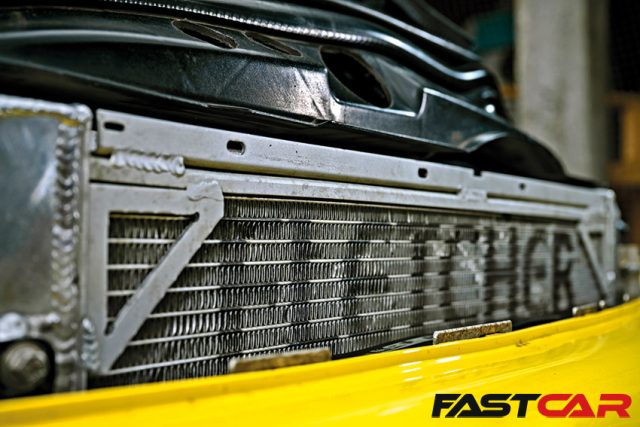We take a dive into the world of intercoolers, from how they work to why they’re an essential part of forced induction car tuning.
What is an intercooler and what does it do?
Unlike car radiators, which are fitted to every internal combustion engine car, intercoolers are a piece of equipment fitted only to forced induction engines. Its job is to help helps remove heat from the charged air. This results in colder, higher-density air travelling to the engine, which in turn leads to increased power potential.
What are intercoolers made of?
Most performance intercoolers are made of aluminum end tanks and cores that are TIG-welded for superior strength. OEM intercoolers tend to have aluminum cores with plastic end tanks that are prone to cracking and leaking.
Are all intercoolers the same?
All intercoolers are not the same; materials, construction, quality and efficiency can greatly vary. There are two primary constructions utilized: bar-and-plate and tube-and-fin. Bar-and-plate is generally considered more efficient at removing heat, but tube-and-fin is often significantly lighter.
There are also multiple variations, including air-to-air. This is where the incoming cold air directly cools the charged air within the intercooler. Additionally, there is liquid-to-air, where a fluid – itself cooled by an external radiator – is used to reduce charged air temperatures. This type is often called a chargecooler to avoid confusion with regular air-to-air intercoolers.
What’s more, intercoolers can also be installed in many different locations in the car. Areas include front-mounted, side-mounted, and top-mounted. Take the Subaru Impreza WRX STI for example, these feature a top-mounted intercooler. But the majority of forced induction cars feature a front-mounted intercooler.
How do aftermarket intercoolers differ from OEM ones?
The primary difference between OEM intercoolers and aftermarket intercoolers is that aftermarket options utilize larger core sizes. This improves cooling capacity by increasing the frontal surface area of the intercooler.
In addition, many aftermarket intercoolers also increase the inlet and outlet diameters. This aids in keeping charge air cooled by permitting a larger mass flow of air to enter and exit the intercooler.
The final primary difference is the design of the core itself, as adjusting the parameters of the bar-and-plate or tube-and-fin design can greatly impact the cooling capacity and flow characteristics of the intercooler.
Why, or when, would you need to upgrade your intercooler?
Most people upgrade their intercooler as part of a tuning package. When increasing an engine’s power output, you also increase the amount of heat it produces, as well as the volume of air it consumes – both of which can affect the intercooler. It’s not uncommon for OEM intercoolers to suffer badly from heat-soak in tuned applications. This results in rising intake air temperatures that can decrease power and risk engine-damaging detonation. Upgrading to a larger, more efficient, performance intercooler mitigates this issue, allowing your car to perform to its maximum potential.
OEM cars are designed to produce a specific amount of power that balances economy, performance and reliability. In the pursuit of more performance, we often negate our focus on economy, but we should never ignore reliability. By improving the cooling capacity of your car, not only will you be able to produce more power, but you’ll be able to do it safely, too.
How important is it to get the right type of intercooler?
Since each vehicle and engine is unique, many direct-fit intercoolers are specific to each application. While a larger frontal surface area is generally the ideal scenario, many variables – such as restrictions in the OEM system, surrounding components, and mass airflow from the turbocharger, to name just a few – have a significant impact on the final design. It’s always worth checking with a specialist to ensure you are getting the right intercooler for your car and its specification.
Also, many specialists now offer various ‘stages’ of upgraded intercooler for the same model, depending on the level of tune. There may be no need to go to the expense of a huge core and big-bore pipework for a mildly tuned application. However, for highly-tuned cars it may be essential for the engine’s health.
What causes factory intercoolers to fail?
A majority of OEM intercoolers use plastic end tanks, which are prone to cracking and failure. In addition, OEM intercoolers are often undersized and quickly become heat-soaked when the engine is tuned, or even when the car is used hard repeatedly, like on a track day, for example. By increasing the size of the intercooler and developing a more efficient design, aftermarket intercoolers are able to keep the air heading to your engine nice and cool at all times.
What other mods should you consider when upgrading your intercooler?
When upgrading the intercooler, look to upgrade the intercooler pipes as well. Many performance kits include the option to add big-bore intercooler boost pipes too. These help to promote smooth airflow throughout the system. Intercoolers are not usually the first upgrade in a chain of mods. Instead they are usually fitted as part of a bigger package; a Stage 2 upgrade kit working together with an exhaust system, air filter and revised mapping, for example.
Are there any downsides to upgraded intercoolers?
Since aftermarket intercoolers are larger than their OEM counterparts, they can sometimes weigh more. But the weight difference is negligible when you consider the performance improvement and the overall weight of the vehicle.
What are the most important things to look out for when buying an uprated intercooler?
It’s the same as when purchasing any aftermarket product; look for a well-tested product from a reputable company. Thankfully, there are a number of trusted specialists producing intercoolers for modified cars, catering for all budgets and all levels of performance; from stage tuning to bespoke motorsport installations.
Relevant content:
Radiators and Intercoolers explained
The post Guide To Intercoolers appeared first on Fast Car.







